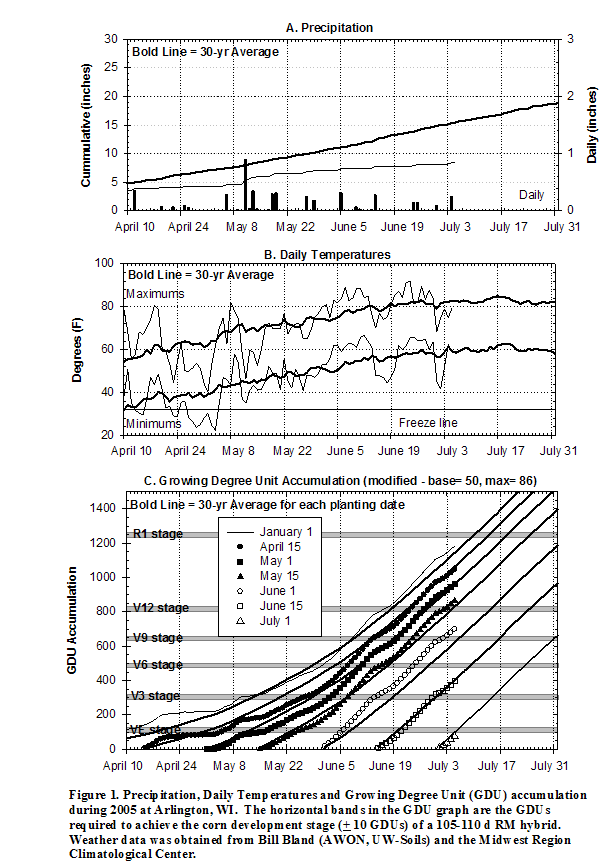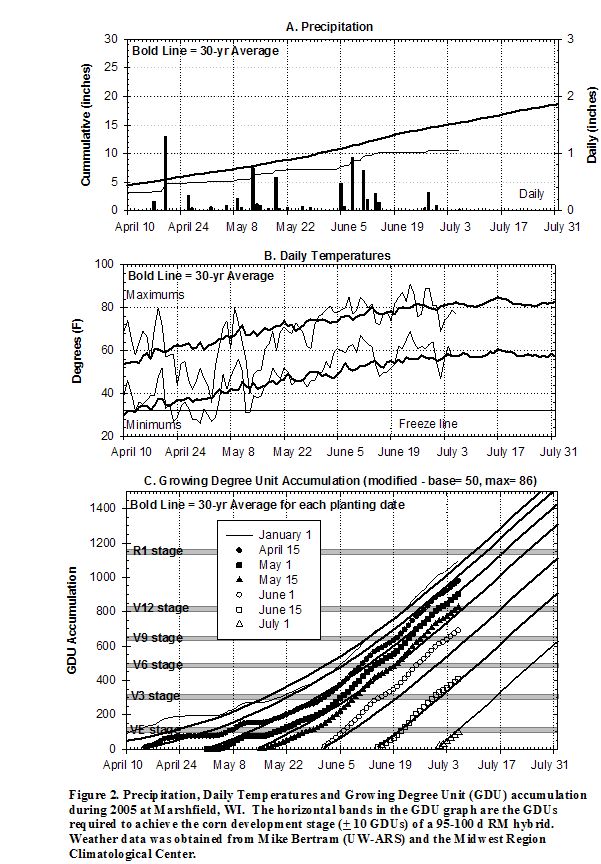
The Corn Crop Needs Rain: It's Time to be Concerned
Joe Lauer, Corn Agronomist
The National Weather Service has classified much of southern and southeastern Wisconsin
as "abnormally dry" and "moderate drought" areas. Spotty rain showers occurred and
farmers have rated the corn condition from excellent to poor in these areas. No
rain is forecasted for the next week. In general, the corn condition improves as
one travels north and west within the state. Early planted cornfields seem better
off than later planted fields.
Figures 1 and 2 depict weather summaries for the UW Agricultural Research Stations
at Arlington and Marshfield. Arlington precipitation from April 1 to July 5 was
4.90 inches in 2005. For the same period during 1988, it was 5.77 inches. It is
the driest year on record for this period since records were kept at the farm beginning
in 1962. Marshfield precipitation during this period has been 7.41 inches in 2005,
and during 1988 was 6.19 inches.
The good news is we are right on the mark for GDU accumulation at both locations
meaning it has not been too hot (like 1988). Corn planted June 1 is ahead for development
and GDU accumulation. All other planting dates are right on schedule. Silking will
begin for the earliest planted fields around July 11, with most of the crop silking
around July 17-20 (the normal silking date).
Research indicates that the most sensitive period that affects corn yield is the
pollination period. The research methods used to determine these sensitive periods
are to quickly withdraw and apply water at different growth stages. That is not
our situation this year. Soil water has steadily depleted over a long period. Soil
moisture is still present because the crop is still growing. Leaf rolling might
occur during the day, but plants are usually turgid the next morning.
The important question is: How much yield potential is lost? We do not have a good
answer for this. In general, I think we are in good shape, but we need rain. There
might some impact on yield with stress at this time, but the plant responds by increasing
root growth at the expense of aboveground leaf area growth. Roots are growing into
the soil profile where they typically may not grow every year. Typically, corn roots
will grow 3 feet to the side of the plant and 5 to 7 feet into the soil profile
in the absence of compaction. Plants experiencing drought will likely be shorter
than normal. The "factory" will be smaller and even if field conditions improve,
yield will likely be reduced.
The pollination period is the most sensitive time for the corn plant because silk
and kernel ovule development are the most water sensitive tissues in the plant.
Tassels typically emerge even under severe water stress. Under stress, tassels will
emerge and shed pollen earlier than normal, but silk emergence is delayed affecting
pollen germination and ovule fertilization. The result is a decrease in kernel number.
So, even if field conditions become favorable during August and beyond, grain yield
is reduced since no kernels were fertilized and developed during the pollination
phase of the corn life cycle.

